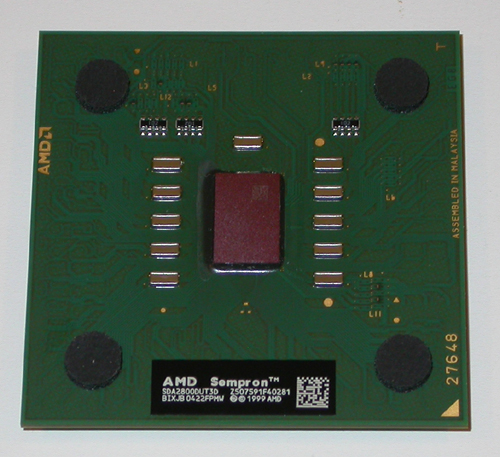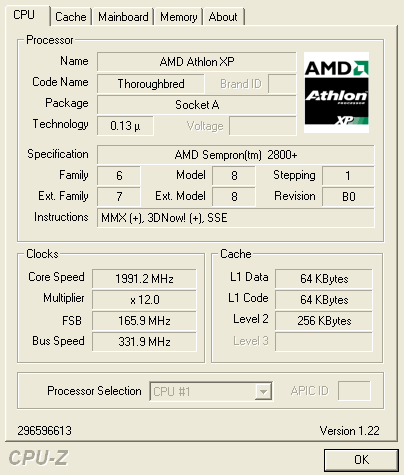AMD Sempron: A Fresh Take on Budget Computing
by Derek Wilson on July 28, 2004 12:01 AM EST- Posted in
- CPUs
Two Flavors are Better than One: Socket A
First in line today is the socket A Sempron based on the K7 architecture.
Socket A Sempron 2800+
If the familiar rectangular shape of the core looks a little too familiar, that's probably for very good reason. The K7 Sempron is actually a 166MHz FSB 256KB Thoroughbred-B core.

Sempron's Secret
Upon first learning this, we were a little worried that we would see overlapping parts where new Semprons would actually be old Athlon XPs. Fortunately, this is not the case.
The slowest Athlon XP 166MHz FSB Thoroughbred-B was the 2600+ with a 12.5 multiplier (2.083GHz core clock). The highest K7 Sempron clock speed is 2GHz with a 12 multiplier.
What this does mean is that higher model numbered Semprons will be slower than "equivalent" Athlon XP processors. This does make a little bit of sense in that Sempron denotes a budget processor, which will be slower than the mainstream line. This is the same type of thing that we see when looking at a 2.8 GHz Pentium 4 versus a 2.8GHz Celeron. They have the same "speed", but different performance.
In our opinion, this is a problem with marketing by clock speed, and we are disappointed to see AMD recreating a problem with artificial model numbers. So now, we have 4 different 2800+ CPUs (AXP Barton, AXP Tbred, Sempron Tbred, A64 Newcastle) and really no reason why this situation should have to exist. Hopefully, future model numbering plans will be better able to handle situations such as this.










55 Comments
View All Comments
abrogard - Tuesday, March 29, 2005 - link
I think there's something should sweep through the internet: Clearly labelling the country of origin of your site! It's not clear which country we are in, often, and therefore what money we're talking.
Followed by clearly dating the page.
abrogard@yahoo.com
:)
cleanjew - Friday, January 14, 2005 - link
Hi, can someone tell me if it would be a good idea to buy a computer running an amd sepron 3000+, i would be using it to run mid range games, and i would like to use internet and productivity software at a fast speed. Do you also think it would be faster than a celeron and comparable to a p4?Thanks
If you want you could email me at jewish-mexican@charter.net
trexpesto - Saturday, August 21, 2004 - link
I just got a Shuttle AN35N and retail TBred 2700+ for ~119 incl. shipping and tax, on sale at outpost.Sparrow - Friday, July 30, 2004 - link
But in the test he say's that the extra 83 MHz make the difference !!!Jens
coldpower27 - Friday, July 30, 2004 - link
I am guessing Anandtech was using the Barton based 2600+, you know the one with 1.92GHZ/333FSB.Sparrow - Friday, July 30, 2004 - link
???? If a Sempron 2800+ is a Thoroughbred (166*12) and the xp 2600+ is a Thoroughbred (166*12.5) why can the Sempron be faster in some test's ? an error or are there some changes in memory speed ????? !!!!!!Jens
MAME - Friday, July 30, 2004 - link
awesome AMD, just awesomethis chip is very nice
coldpower27 - Friday, July 30, 2004 - link
Hey Trogdor, notice I can post here now too:)Anyway, just to sum up I would like to see these processor as well.
Athlon XP-M Barton @ 2.3,2.4,2.5 using 200x11.5, 200x12, 200x12.5
Celeron Northwood-128
2.4,2.5,2.6,2.7,2.8
Celeron Prescott-256
2.4,2.53,2.66,2.8
Duron Applebred
1.4,1.8
Pentium 4 Northwood, Prescott
2.8 with FSB800
Zebo - Thursday, July 29, 2004 - link
oh LOL:)TrogdorJW - Thursday, July 29, 2004 - link
Woah, KF... that was a whole lot of stuff to post, quite a bit of it rather unrelated. You must have even more free time than me! ;)Zebo, you apparently missed the point completely: "The overlapping Athlon FX, Athlon 64, and now Sempron names is going to really cause confusion among the *less-informed* public." The less-informed public doesn't include anyone reading hardware sites or OC forums. Yeah, Sempron is the value system meant to compete with Celeron, but both AMD and Intel are happy to sell lots of slower, "crippled" chips to the uninformed buyers. The 2.8 GHz Celeron chips were absolutely terrible performers - about as fast as a P4 1.8 or 2.0 - but Intel was more than happy to dupe people into purchasing those with their high clockspeed. The Celeron D is better, but the tactic remains the same. AMD is now joining them, calling lesser processors "3100+" and "2800+" and leaving it to the salespeople.
You don't think there are going to be plenty of salespeople pushing these systems with claims like "the Sempron 2800+ is basically just as fast as a 2.8 GHz chip, and the only difference between it and the Athlon 64 2800+ is the lack of 64-bit support, which really isn't needed anyway"? In sales, it's a lot more important to get a sale than to get a big sale. They'll shoot for the big sales if possible, but when someone wants a cheap system, they'll talk up the Sempron (and/or Celeron) as though it's just as good as a more expensive Athlon64/Pentium4.
That's what I meant when I said it's creating confusion, and that the confusion is likely to be an intended consequence. Car manufacturers do the same thing: you don't want an informed purchaser coming in to buy a car! You want the salesman to have the advantage, so that they can get the buyer into *any* Ford, Chevy, Honda, etc. and keep them from going to a different store.
Most PC shos (and car dealerships) make a set amount of money off of a sale, because the hard drives, case, monitor, RAM, etc. all have markups. So if someone buys a computer, the shop makes at least $100. $100 on a $500 computer is a good return. If they buy a $1000 computer, they might make $150 to $200. Granted, on the "luxury" computer systems that cost over $2000, they'll make a killing, but those are hardly ever sold.